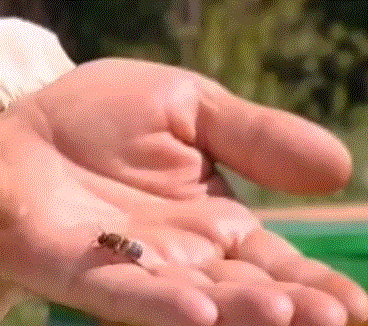Drones in a bee colony
Photo of what a drone looks like
The drone is the male part of the bee colony. Therefore, in this material we will look at who drones are, why drones are needed in a bee colony, how many drones are in a bee colony, as well as a lot of other useful and interesting information for a beekeeper. Read to the end - it will be interesting and useful!
Content
- Drone in a bee colony
- What does a drone look like?
- The role of drones in the bee colony
- What does a drone do in a bee colony?
- How long do drones live?
- How many drones are there in a bee colony?
Drone in a bee colony
What does a drone look like?
To understand what a drone looks like, look at the frame with bees in summer and you will see a drone. A drone differs from a bee in its dimensions - it will be larger than it, the drone weighs approximately 250-260 mg, the length of the drone is only 15-20 mm. Pay attention to the wings - the drone has massive, well-developed wings, it has large eyes and an almost invisible honey proboscis. This is what a drone looks like in a bee colony, pay attention to the photo of the drone.
The role of drones in the bee colony
What is the role of drones in a bee colony, what does a drone do in a bee colony? First, let's look at who drones are. Drones are the male members of the bee colony. As a rule, drones live in their own bee colony, but they can also fly into other hives, where the bees always welcome them. They are fed by worker bees, but drones can, if necessary, feast on honey from the honeycombs themselves. What does a drone do in a bee colony? The answer does nothing, it does not participate in honey collection or in raising the brood.
Drones live in a bee colony, as a rule, only during the summer. Bees raise drones starting at the end of May and continue until honey flow stops (until the end of July in the middle zone). At this time, up to 90% of the drone brood is grown; the bees hatch the most drone brood in the second half of June. In the middle zone (Ryazan region), in early May and early August, only individual bee colonies raise drone larvae. To raise drones, bees build drone cells, the drone cells of which are larger in size than the cells for hatching ordinary worker bees. The queen bypasses the drone honeycombs, laying unfertilized eggs in them.
Drones in a bee colony are clearly visible among worker bees due to their large body size. The length of the drone is 15-17 mm, the body weight of the drone, depending on the breed, is 196-256 mg.
What does a drone do in a bee colony?
But if drones do not carry honey and do not perform intra-hive work, then what is the function of a drone in a bee colony? The function of drones in a bee colony is that after 10 days of age, drones become sexually mature and fly out of the hive in the afternoon to mate with young queens. This is why drones are needed in a bee colony - insemination of the queen is their function and task in life.
How long do drones live?
How long do drones live? The drone dies after mating with the queen.
In autumn, to save food, bees begin to expel drones from the hives, which indicates the end of honey collection and the beginning of preparations for wintering. However, in bee colonies where the young queen has not yet had time to be fertilized, the drones are left for the winter as equal members of the bee colony.
Thus, drones in a bee colony perform an important function, but their number is disproportionate to needs. In addition, to perform the functions of drones in a bee colony, individuals obtained from high-quality queens are needed so that the bee colony can be strong. The role of drones in a bee colony is to pass on their genes to future bees. Therefore, in nature, only the largest and strongest drones can catch up with the queen.
How many drones are there in a bee colony?
How many drones in a bee colony are needed to perform their function. For high-quality insemination of the queen, only 6-12 drones are required, but the strongest ones, while a bee colony can contain hundreds and thousands of drones.
How do drones in a bee colony feed? The drones are fed by worker bees, but if pressed, the drones themselves can get honey from the honeycombs. They are quite voracious; bees spend 7 kg of honey to feed every thousand drones. Over the course of their entire life, 1 kg of drones consumes 15 to 20 kg of honey, which is approximately 2.6 times more than 1 kg of worker bees will eat.
It should be said that drones are hatched in each bee colony, and the more a bee colony swarms, the more drones there are in the bee colony, but in an apiary you don’t need so many drones of this quality, it is enough to keep several breeding colonies in the apiary to breed breeding drones. In ordinary bee colonies, it is possible to organize the production of drone homogenate; for this, a building frame can be used, which will also reduce the number of varroa mites in the bee colony.

